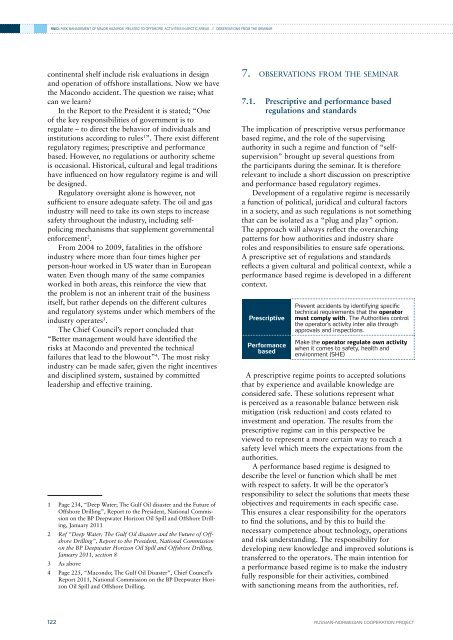phase 4 report - DNV
phase 4 report - DNV
phase 4 report - DNV
Create successful ePaper yourself
Turn your PDF publications into a flip-book with our unique Google optimized e-Paper software.
RN03: RISK MANAGEMENT OF MAJOR HAZARDS RELATED TO OFFSHORE ACTIVITIES IN ARCTIC AREAS // observations from the seminarcontinental shelf include risk evaluations in designand operation of offshore installations. Now we havethe Macondo accident. The question we raise; whatcan we learn?In the Report to the President it is stated; “Oneof the key responsibilities of government is toregulate – to direct the behavior of individuals andinstitutions according to rules 1 ”. There exist differentregulatory regimes; prescriptive and performancebased. However, no regulations or authority schemeis occasional. Historical, cultural and legal traditionshave influenced on how regulatory regime is and willbe designed.Regulatory oversight alone is however, notsufficient to ensure adequate safety. The oil and gasindustry will need to take its own steps to increasesafety throughout the industry, including selfpolicingmechanisms that supplement governmentalenforcement 2 .From 2004 to 2009, fatalities in the offshoreindustry where more than four times higher perperson-hour worked in US water than in Europeanwater. Even though many of the same companiesworked in both areas, this reinforce the view thatthe problem is not an inherent trait of the businessitself, but rather depends on the different culturesand regulatory systems under which members of theindustry operates 3 .The Chief Council’s <strong>report</strong> concluded that“Better management would have identified therisks at Macondo and prevented the technicalfailures that lead to the blowout” 4 . The most riskyindustry can be made safer, given the right incentivesand disciplined system, sustained by committedleadership and effective training.1 Page 234, “Deep Water; The Gulf Oil disaster and the Future ofOffshore Drilling”, Report to the President, National Commissionon the BP Deepwater Horizon Oil Spill and Offshore Drilling,January 20112 Ref “Deep Water; The Gulf Oil disaster and the Future of OffshoreDrilling”, Report to the President, National Commissionon the BP Deepwater Horizon Oil Spill and Offshore Drilling,January 2011, section 83 As above4 Page 225, “Macondo; The Gulf Oil Disaster”, Chief Councel’sReport 2011, National Commission on the BP Deepwater HorizonOil Spill and Offshore Drilling.7. observations from the seminar7.1. Prescriptive and performance basedregulations and standardsThe implication of prescriptive versus performancebased regime, and the role of the supervisingauthority in such a regime and function of “selfsupervision”brought up several questions fromthe participants during the seminar. It is thereforerelevant to include a short discussion on prescriptiveand performance based regulatory regimes.Development of a regulative regime is necessarilya function of political, juridical and cultural factorsin a society, and as such regulations is not somethingthat can be isolated as a “plug and play” option.The approach will always reflect the overarchingpatterns for how authorities and industry shareroles and responsibilities to ensure safe operations.A prescriptive set of regulations and standardsreflects a given cultural and political context, while aperformance based regime is developed in a differentcontext.PrescriptivePerformancebasedPrevent accidents by identifying specifictechnical requirements that the operatormust comply with. The Authorities controlthe operator’s activity inter alia throughapprovals and inspections.Make the operator regulate own activitywhen it comes to safety, health andenvironment (SHE)A prescriptive regime points to accepted solutionsthat by experience and available knowledge areconsidered safe. These solutions represent whatis perceived as a reasonable balance between riskmitigation (risk reduction) and costs related toinvestment and operation. The results from theprescriptive regime can in this perspective beviewed to represent a more certain way to reach asafety level which meets the expectations from theauthorities.A performance based regime is designed todescribe the level or function which shall be metwith respect to safety. It will be the operator’sresponsibility to select the solutions that meets theseobjectives and requirements in each specific case.This ensures a clear responsibility for the operatorsto find the solutions, and by this to build thenecessary competence about technology, operationsand risk understanding. The responsibility fordeveloping new knowledge and improved solutions istransferred to the operators. The main intention fora performance based regime is to make the industryfully responsible for their activities, combinedwith sanctioning means from the authorities, ref.122RUSSIAN–NORWEGIAN COOPERATION PROJECT






![Risk Based Pipeline Integrity Management [Compatibility Mode] - DNV](https://img.yumpu.com/50424229/1/190x146/risk-based-pipeline-integrity-management-compatibility-mode-dnv.jpg?quality=85)









